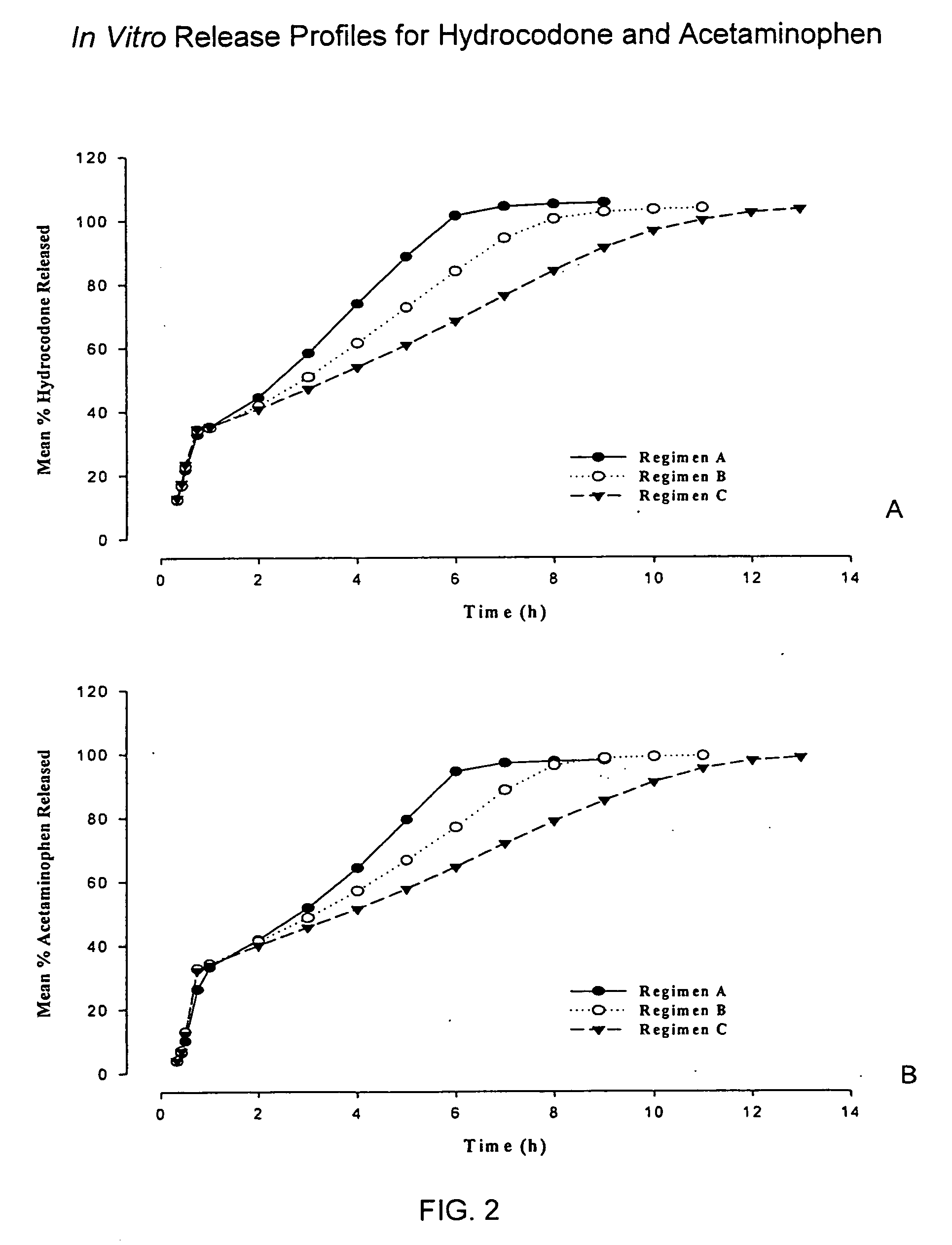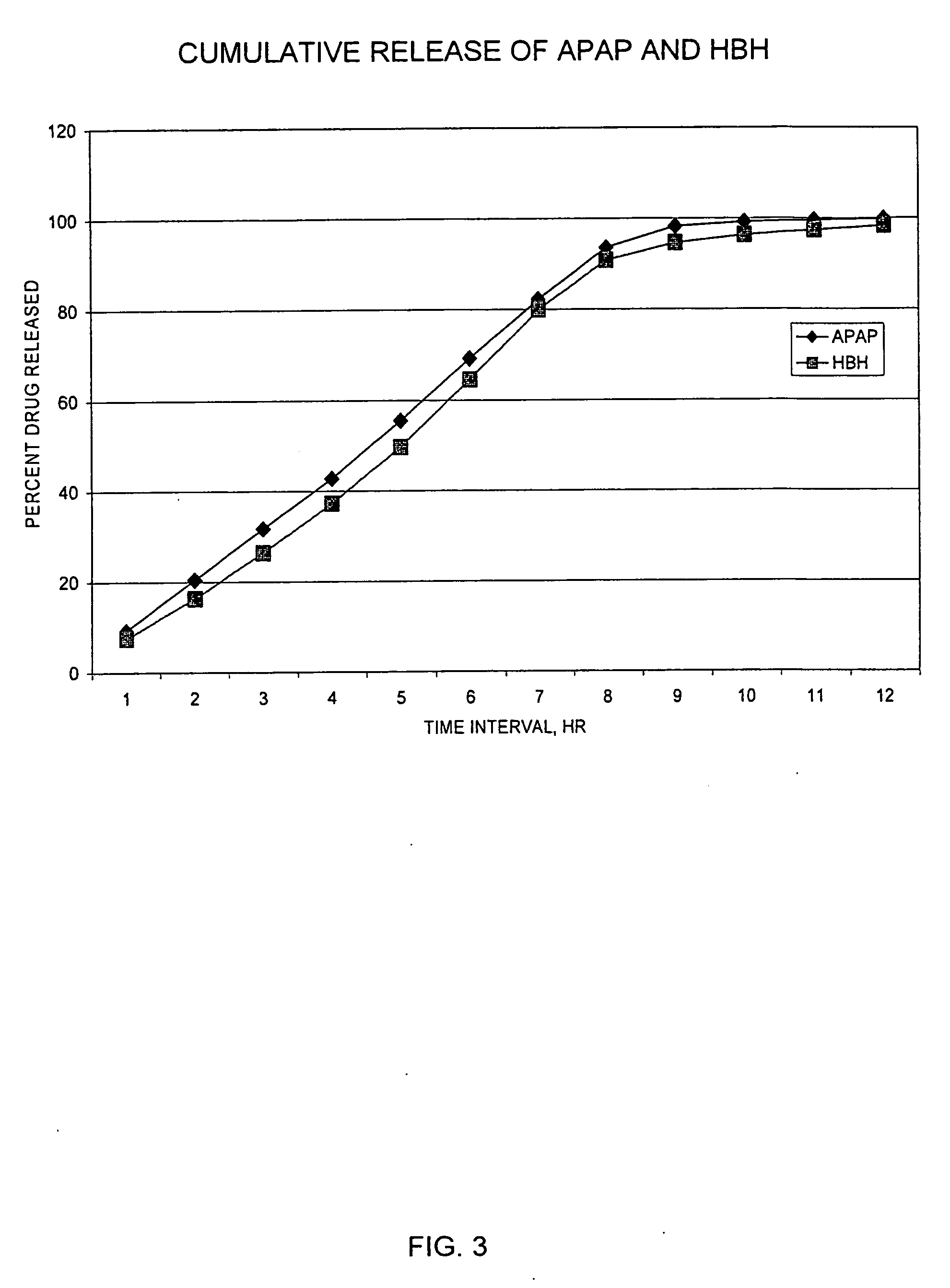Controlled release formulations of opioid and nonopioid analgesics
a technology of nonopioid analgesics and controlled release, which is applied in the field of solid dosage forms, can solve the problems of high residual drug concentration in the formulation, insoluble drugs such as certain nonopioid analgesics are more difficult to prepare, and opiate analgesics were not combined, so as to achieve rapid plasma concentration rise and reduce pain intensity
- Summary
- Abstract
- Description
- Claims
- Application Information
AI Technical Summary
Benefits of technology
Problems solved by technology
Method used
Image
Examples
example 1
[0310] A dosage form containing 500 mg acetaminophen and 15 mg hydrocodone was prepared using procedures as follows:
Preparation of the Drug Layer Granulation
[0311] A twenty five kilogram lot of the drug layer was granulated using the medium fluid bed granulator (mFBG). A 5% manufacturing excess of hydrocodone bitartrate (HBH) was added to maintain target drug amounts in the compressed cores as established during the experimental scale up work. The binder solution was prepared by dissolving the povidone in purified water making a 7.5 wt % solution.
[0312] The specified amounts of APAP, polyethylene oxide 200 K (polyox N-80), croscarmellose sodium (Ac-di-sol), and poloxamer 188 were charged into the FBG bowl. The bed was fluidized and the binder solution was sprayed immediate thereafter. After 1000 g of the binder solution had been metered into the bowl, the granulation process was stopped the preweighed HBH was then charged into the bowl by placing it in a hole in the granulation ...
example 2
[0339] An alternative formulation was prepared according to the procedures described in Example 1 above, varying certain of the constituents.
[0340] The components which make up the dosage forms are set forth as weight percent composition in Table 7 below.
TABLE 7Formulations for Hydrocodone Bitartrate / Acetaminophen TabletsPush Displacement Layer: 138 mgPolyethylene Oxide, NF, 303, 7000 K, TG, LEO64.30Sodium Chloride, USP, Ph Eur, (Powder)30.00Povidone, USP, Ph Eur, (K29-32)5.00Ferric Oxide, NF, (Red)0.40Stearic Acid, NF, Powder0.25BHT, FCC, Ph Eur, (Milled)0.05Drug Layer: 413 mgPolyethylene Oxide, NF, N-80, 200 K, TG, LEO2.55Hydrocodone Bitartrate, USP2.42Acetaminophen, USP (fine powder)80.00Poloxamer F188 (Pluronic F68), NF, Ph Eur8.00Croscarmellose Sodium, NF3.00Povidone, USP, Ph Eur, (K29-32)3.00Stearic Acid, NF, Powder0.75Magnesium Stearate, NF, Ph Eur0.25BHT, FCC, Ph Eur, (Milled)0.03Subcoating: 10 mgHydroxyethyl Cellulose, NF95.0Polyethylene Glycol 3350, NF, LEO5.0Membrane C...
example 3
[0342] Additional formulations were prepared according to the procedures described in Example 1 above, varying the amounts of the binder. In particular, four formulations having identical compositions to the formulation of Example 1 were prepared, with the following exceptions:
[0343] The drug layer composition was prepared as described, using a finer grade of acetaminophen (Ph Eur Fine Powder), utilizing a push displacement layer containing a lower amount of polyethylene oxide, NF, 303, 7000K, TG, LEO (61.3%), and an additional 3% glyceryl behenate, NF, Ph Eur, using a different grade of hydroxyethylcellulose in the subcoat (NF, Ph Eur, 250 LPH), and a drug coating containing a different amount and grade of acetaminophen (87.584%, Ph Eur micronized) and a lower amount of hydrocodone bitartrate (2.576%);
[0344] The drug layer composition was prepared as described, using 2.55% hydroxypropylcellulose EXF instead of polyethylene oxide N-80, a lower amount of acetaminophen (78.787%) and...
PUM
| Property | Measurement | Unit |
|---|---|---|
| concentration | aaaaa | aaaaa |
| concentration | aaaaa | aaaaa |
| concentration | aaaaa | aaaaa |
Abstract
Description
Claims
Application Information
 Login to View More
Login to View More - R&D
- Intellectual Property
- Life Sciences
- Materials
- Tech Scout
- Unparalleled Data Quality
- Higher Quality Content
- 60% Fewer Hallucinations
Browse by: Latest US Patents, China's latest patents, Technical Efficacy Thesaurus, Application Domain, Technology Topic, Popular Technical Reports.
© 2025 PatSnap. All rights reserved.Legal|Privacy policy|Modern Slavery Act Transparency Statement|Sitemap|About US| Contact US: help@patsnap.com



